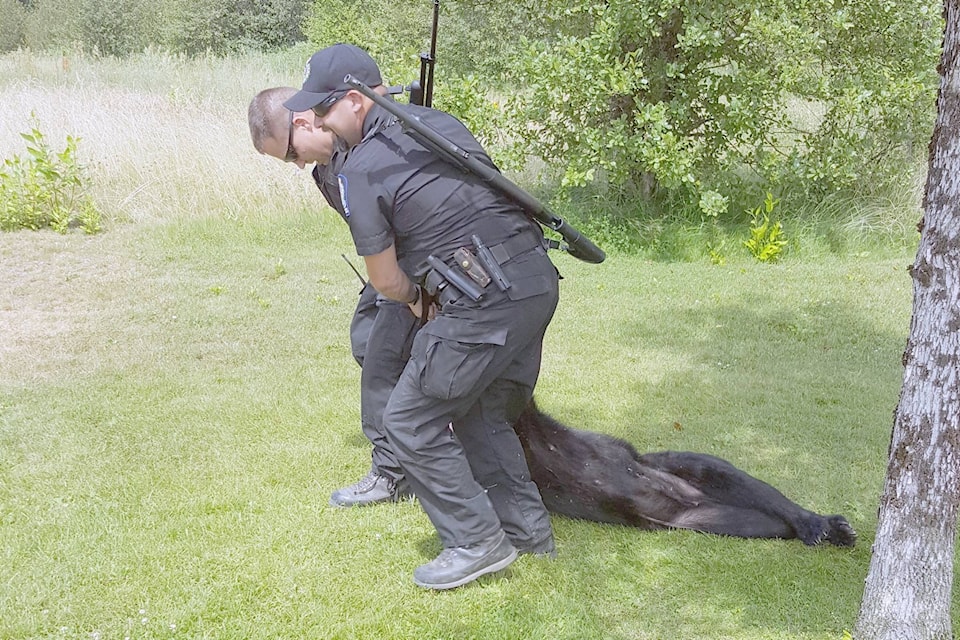Ryan Sellars and his family were enjoying a hot weekend afternoon at the Millennium Ponds when they noticed some unusual activity going on around the first pool.
A bear had decided to hang out in the area and ended up in a tree.
“We heard the crack of branches — and then they pulled the bear out,” said Sellars.
He said most people at the ponds at the time didn’t really notice what was going on until the officers were standing near the tree where the bear was.
“No one was really looking until about five minutes before the shot,” said Sellers. “No one really felt threatened, because they did not really know what was going on.”
Sellars said the the officers assured the bystanders that the bear was fine and had just been tranquilized, but conservation officer (CO) Ben Beattlestone confirmed that the bear was later euthanized.
Though the bear may not have been threatening anyone when it was removed from the park, Beattlestone said it was a food-conditioned bear.
The B.C. Conservation Officer Service’s (COS) policy is not to relocate food-conditioned bears.
“It was tranquilized to save the shock and necessity of having to put the bear down in front of numerous people,” Beattlestone explained.
Explaining the policy on food-conditioned bears
Mike Badry, provincial wildlife conflict manager, explained that there are two steps to a bear becoming food-conditioned.
“They become habituated to people, which is basically losing their wariness, their fear of people,” he said. “Over time, as they get exposed to people and there’s no negative encounters, they lose that wariness.”
Once the bears are comfortable around people, they find human food sources.
“And that’s when they become what we term food-conditioned. They make that association that people equal food,” explained Badry.
When COs receive calls about bear conflicts they make an assessment regarding the risks to public safety, which then guides their response, he continues.
“When we have bears that have gone through these habituation and food-conditioning processes, those bears are becoming a high risk,” says Badry.
If COs can catch a bear before it becomes habituated, there is a chance to change the behaviour by getting the bear to associate humans with negative stimuli.
“But it’s really key that, that happen early in any kind of a response because once they have associated people with food, that behaviour is next to impossible to turn around,” says Badry. “There is no amount of negative stimuli you can apply to a bear that’s going to keep them from accessing a food source that they know is there.”
Badry says that for this reason, the COs focuses on conflict prevention, trying to deter bears before they gain access to attractants.
Asked why food-habituated bears aren’t able to be relocated, Badry explained, “We’ve really been trying to remove long-distance translocation as an option for bear conflict response, because it isn’t effective. These bears, that again have already become food-conditioned, we take them and move them a long distance and drop them into unfamiliar habitat that we may think is good bear habitat, but it may already be completely occupied by bears — and in fact, in this province, it likely is.”
Badry explained that bears that are translocated long distance either die (eaten by a larger bear, starve to death, freeze to death, run over) or wind up back in a community — sometimes the same one they came from — after facing numerous risks.
“Translocation is a very stressful thing to do to an animal,” he said.
But short-distance translocation or relocation can work on a bear that hasn’t yet become habituated.
“You can take a bear and move it a short distance, in an area that it’s still familiar with, maybe just move it to the outside of town, and release it. But it hasn’t gotten a food reward, “says Badry. “That’s not a very pleasant situation for the bear to be in, so hopefully it will act as that negative stimulus.”
If you encounter a bear while out, Badry says the best thing is to remove yourself from the situation and call the RAPP line at 1-877-952-7277. If you’re at home and there’s an area where you can remain safe from the bear, you can try making noise to scare it off.
“We don’t want people to make bears feel comfortable. The last thing we want people to do is stay quiet and try to get closer to the bear, try to take pictures of the bear. That’s simply going to increase that habituation level that, that bear may already be having,” said Badry.
Badry also emphasized the need to control the bears’ access to attractants in order to reduce conflicts.
“We’re lucky to live in a province that has healthy, large carnivore populations, but with that comes the responsibility that [people] manage things appropriately to reduce conflicts,” he said.
If you have a comment, complaint or compliment for the COS, please contact them via their website at www2.gov.bc.ca/gov/content/environment/natural-resource-stewardship/natural-resource-law-enforcement/conservation-officer-service/contact-information, rather than contacting your local CO directly.
